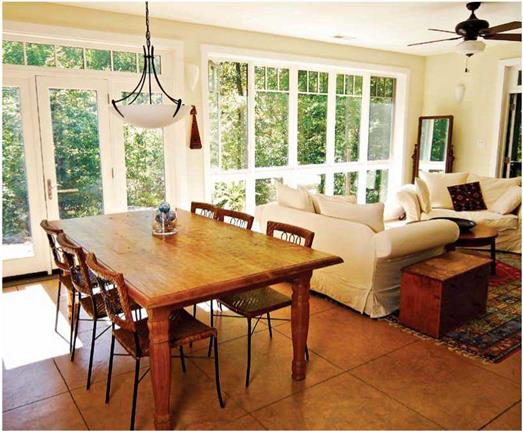Control Heat with Mass
With the correct orientation and southfacing windows, your house can have great light and heat in winter—but it also can have the potential for overheating if you don’t balance the amount of windows in the house with the amount of mass. Thermal mass comes from materials that absorb heat, such as concrete, tile, brick and concrete
 Floor mass. The floor is the easiest place to add thermal mass, which regulates temperatures all year long. This colored concrete floor is covered with a soy-based sealer and runs throughout the first level of the house. During the day, it absorbs excess heat from the south-facing windows, releasing it at night.
Floor mass. The floor is the easiest place to add thermal mass, which regulates temperatures all year long. This colored concrete floor is covered with a soy-based sealer and runs throughout the first level of the house. During the day, it absorbs excess heat from the south-facing windows, releasing it at night.
block, and water. However, water requires diligence to prevent algae and mold, and it is harder to incorporate into the structure of a house. The easiest mass to build into a house is some form of masonry.
Generally, the more south-facing windows there are, the more mass a house needs to balance the heat gain indoors and keep it cool. When sun shines through the windows, it strikes interior surfaces. Sunlight can either radiate into the air, heating the house, or be absorbed by the material it strikes. If it is absorbed, you get light in the house but not heat. Because heat moves from hot to cold, the mass material will continue to absorb heat as long as it remains colder than the surrounding air.
The right amount of thermal mass draws heat out of the air during the day, and radiates the heat to warm the home in the evening when the air temperature drops, making mechanical heating less necessary. In the morning, when the atmosphere heats up
once more, the cooled mass material starts to absorb the day’s heat all over again.
The easiest way to add mass to a house is on the floor. A significant amount is needed: In a typical passive-solar home, the concrete, tile, or brick floor should be 4 in. thick. Tile installed on cementboard on a subfloor is not enough.
Trombe walls are another design option. They are interior masonry walls behind south-facing windows with a narrow airspace between them. When the sun comes in, the heat is trapped in the airspace and then is absorbed by the wall. It acts as a heat sink for the house and can radiate the heat inside.
If you’re planning a new house, you also can build mass into the walls. Precast concrete panels or AAC blocks introduce a significant amount of mass. These walls can be finished in a variety of ways; stucco is the simplest and most low-maintenance option, but you can attach siding if you prefer.
On the inside, concrete panels are typically painted, while the AAC can be finished with stucco or drywall. Finished this way, the interiors look like any other house, except for the added aesthetic of deep windowsills.
Thermal mass has an added benefit: Not only does it absorb heat, but it’s also cool to the touch, which cools you. You can keep the air temperature of your home several degrees higher in the summer if you’re walking on a cool floor. One way heat is transferred is through conduction—the movement of heat from one object to another through direct contact. You touch the floor, and because you are warmer than the floor, the heat in you (the warmer object) moves to the floor (the cooler object). You feel cooler, no mechanical means required.
Massing is the hardest strategy to add to an existing home. If the house was not designed to accommodate a 4-in.-thick masonry or concrete floor, it’s not easy to add one. If you are adding to the south side of your house, however, you can consider a slab floor, a masonry wall, or a masonry fireplace.






Leave a reply